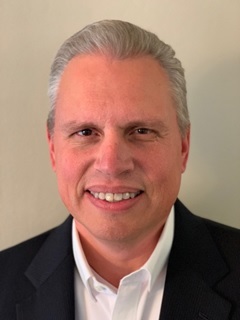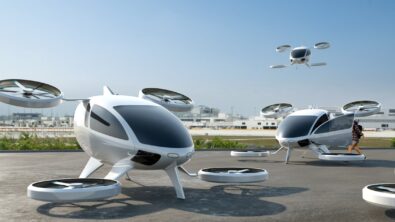“Zero-emissions aircraft”– Conceptual Thinking and Preliminary Design – ep.2 Transcript

Welcome again to Season #5 of Talking Aerospace Today. This second episode of our five-part series on zero-emissions aircraft discusses Conceptual Thinking and Preliminary Design. Enjoy the podcast!
My discussion with Dale Tutt is transcribed below, or listen to the podcast.
Read the podcast transcript:

Scott Salzwedel: Hello, this is Talking Aerospace Today, a podcast for the aerospace and defense industry. A place that brings the promise of tomorrow’s technology to the ears of our listeners today. And I’m your host, Scott Salzwedel.
Welcome to our new five-part series “The Future of Air Mobility: Zero-emissions Aircraft”. In our previous episode, episode one, Dale and I discussed how the industry is preparing for a greener future through zero-emissions aircraft. We touched on Sustainable Aviation Fuels, or SAF, and the progress being made. Certainly, eVTOLs and Urban Air Mobility vehicles are part of that zero-emissions equation as well. Even when we look at the more conventional aircraft, we’re seeing progress with hybrid electrical propulsion. Further down the line, there’s promise that hydrogen fuel cells will play a prominent role in zero-emissions aircraft.

So, today, in episode two, an episode we’re calling the “Zero-emissions Aircraft – Conceptual Thinking and Preliminary Design, we’ll be focusing on the many decisions required in the early concepting stage of a zero-emissions aircraft, and how these decisions feed into the preliminary design. I’m pleased to introduce my special guest and partner Dale Tutt who is Vice President of Aerospace and Defense at Siemens Digital Industries Software. Welcome, Dale, thanks for stopping by.
Dale Tutt: Hi, Scott. It’s great to be here today. And I’m very excited about today’s topics. I’ve been involved in the conceptual design on several aircraft, and it’s always a fun time for dreaming about new airplanes. But it’s also where a lot of critical decisions are made that can really make the difference between the success or failure for a program. So, this will be a very interesting topic to talk about.
Scott: So, here we are. We’re in the very early stages of developing a zero-emissions aircraft. We’re not sure exactly what type of vehicle we want. We have a general idea, but there are so many variables to consider. So, how do you begin that process early on?
Dale: When you think about a zero-emission aircraft, and in this case, maybe you’re thinking about an Urban Air Mobility type of vehicle, there are so many missions sets and so many different things that you have to consider. So, are you going to operate regionally? Or are you going to primarily be in an urban area? What kind of a system are you operating in? Is it a hub- and-spoke type system or just free form? And maybe how far you’re going to go? If you’re going to fly just 25 miles versus maybe 125 miles – it sizes the airplane differently. How fast do you want to go? How many passengers you’re going to have? And then when you start thinking about different design configurations of some of these Urban Air Mobility vehicles, where you have maybe a tiltrotor or a quadrotor, or in some cases, eight or 10, 12 different rotors. And then if you’re going to be designing an air taxi or a personal commuting vehicle? This influences the design and the decisions you make. Is it going to be manned or autonomously piloted? And then how many charging stations and what kind of facilities do you need for runways or airports? So many different decisions that you need to think about when you’re first coming up with a concept, is there are a lot of trade-offs.
Scott: Speaking of trade-offs, can you touch on a few of the key trade-offs you’re considering at this point? I’m sure complexity is one of those trade-offs and cost.
Dale: Complexity is certainly one of those trade-offs. And then the cost of the program. And even the cost of the product, the manufacturing costs. A lot of companies will have a parametric model for some of these things. But in addition to cost, the schedule – can you get to the program and get it to the market in time? And what new technologies are we going to be looking at? And are they ready for primetime? Or do you need to do more development on some of these new technologies? Certainly, weight and performance, and the power source, and how many batteries you’re going to have is going to play into it. And are going to be able to build it in the numbers that you want to be able to build? And even thinking further ahead beyond manufacturing – are you going to be able to support it? And staffing for the program – do you have the right people? Where are you going to build it at? All of these things are decisions that influence the design decisions for the vehicle that you’re going to design and build.
Scott: What are some of the other activities happening in this early conceptual phase?
Dale: Usually, when you’re thinking about concept design phase, and as I said, it’s sometimes still kind of fuzzy what you’re going to be working on. But a lot of times we have this activity that we call multi-disciplinary analysis and optimization. It’s very complex. You’re trying to develop this optimal product design and an architecture for the product. And these concepts I was talking about like tiltrotor versus quadrotor, or maybe number of rotors. You need to worry about the shape of the vehicle, and what systems you’re going to have inside the vehicle because that will drive manufacturing costs. If you’re going to use an air taxi, you need to be balancing the different types of mission scenarios. So, from the top-level requirements, the cabin volume, how many rotors you’re going to have? Where they’re placed? What might the electrical system look like? Even some things like what are the different types of software control laws that you might have for each different vehicle configuration?
So, it’s the structure and systems and software integrated optimization you need to do. During this phase, you want to look at thousands of options, and you really want to understand the performance, and what’s the business case, and even the manufacturing cost of each configuration. And the challenge has been that with traditional tools, you might be able to realistically look at 10 or 20 options, but that’s about it. You only have so much time and so you use some good judgment. But with digital tools, you want to automate a lot of these activities. So, by connecting the dots and connecting the different solutions together, you can start to automate the processes. Now, by tapping into the power of the digital twin, you’re able to generate thousands of options and really optimize to the best solution that meets all the requirements and really builds the best business case for your product. And it really does drive a lot of your downstream decisions. Later on, these decisions that you make at the beginning of the program.
Scott: So you mentioned the digital twin. What about the digital thread? Does this play a role here in this stage?
Dale: You’re going to start putting a lot of new digital threads to work. And if you really want to go fast, you want to be able to reuse as much of this information from the early design phases and continue to grow and mature it throughout the entire development process. And so when we talk about some of the digital threads that you’re putting to work, for example, your model- based systems engineering digital thread – during the conceptual design phase, you’re capturing your customer requirements and what you need for the program; you’re defining the technical requirements for the program. And you’re starting to really, as I mentioned earlier, trying to optimize your product architecture, the technologies you’re going to use. You might even start talking about what suppliers are you going to either work with or partner with to achieve your business objectives for your program. And then finally, you’re starting to build your delivery plan for your capability to really start supporting an agile engineering approach which we’ll talk about a little bit later.
Another digital thread, another area that you really want to focus on is your program management, what we call integrated program planning and execution. And a lot of times, people think about program management as later on in the program when you start building a really solid program plan and then you start executing that program plan. But this really starts in the concept design phase. When you’re just building a proposal, you’re building a business plan and you need to propose and sell it. And so you need to make sure that you have enough of an understanding of the program, you have a solid basis of estimates that you can use to actually build a good program plan that you can make a rational decision on and really minimize the risk of significant cost or schedule overruns. And so you’re building this plan, you’re estimating the program costs, you’re estimating the scheduled time, and you’re looking at your program risks. So, all of these program management activities, you’re starting these in this early proposal phase. And so at some point in time, when you have a program go or program authorization to proceed, that that’ll be later on, that may be a later design, like preliminary design review. So, you really want to focus on that.
And then finally, interestingly enough, verification management. You start building the digital thread for verification as early in the process as you can. You don’t want to wait until it’s time to start certifying the airplane to build this thread, you want to start early. And the reason for that is because as you start to think about how you’re going to show compliance for the vehicle. What kind of test articles you’re going to need? How many flight test articles do you need? And by building this verification plan early, and at least starting that process, that information feeds into the business plan that we were talking about earlier as we’re talking about integrated program planning execution. And so as you’re aligning with your authorities, you’re understanding your serve basis – all of this drives your cost. And so you start building these digital threads as early as possible and making sure that you can meet your program requirements. And so all these digital threads really start tying together earlier. They’re not later in the program, they start at the beginning of the program.
Scott: Let’s say we’ve done our due diligence and we’ve got these three digital threads up and running, and now we’re ready for a preliminary design. So, what happens in this phase as we move along?
Dale: If you think about how a company might start in a program, the concept design phase maybe only have 20 or 30 very specialized people working on the program. But as you move into the preliminary design phase, you’re starting to really get more technical maturation of your product and you have more people working on the program. So, maybe by the end of this phase, you might have 100 people working on the program. But what you’re doing during this phase is you’re developing your preliminary layouts of your product, you might finalize the outer mold lines or the outside shape of the aircraft, thinking about all the primary structural load pass where are your big frames at, where are your wing spars, and if you have a wing, and where are your major structural elements out? Where is your light landing gear located? So, in addition to doing the structural load pass, you’re also reserving space for all the systems routings and the components that you have a place for everything. And that you know, again, it’s giving you confidence that you have a product that you can proceed with, and in another piece of it.
So, as we’ve talked about your developed architecture, you’re developing the 3D geometry. You’re also starting to define all the necessary interfaces that you have between all these different systems. And this is a huge task. And it’s often overlooked by a lot of companies until they start having problems later on as they start to bring big chunks of an aircraft together. So, you need to understand all the interfaces between all the different suppliers, between the systems and subsystems, as well as just between different components. And so if you have electrical boxes that need to talk to each other, within, say, your flight control system, you need to be able to understand what the signals are and what do those connections look like, and even all the mechanical interfaces with your structure. So, it’s a pretty big task, but a lot of times really starts to get defined much better during the preliminary design phase.
Scott: So, preliminary design phase, and then obviously, we would move into the actual design phase itself. And we talked about some of these digital threads already. So, in the design phase, how do you see these digital threads working?
Dale: As you move deeper into the process, and you move from concept design to preliminary design, as part of that technical maturation, you’re also doing a bit of a digital thread maturation. It’s a living element – your digital twin, digital thread live throughout the entire program. And so as you think about MBSE, as it relates to this design phase, the focus in concept design was maybe on the product – what does the product look like? Now you start looking at what are your systems architectures look like? What does your electrical system look like? Maybe your pneumatic system because you want to keep the passengers cool and comfortable. And so you want to understand what those systems look like. You’re looking at alignment on all the interfaces with all of your suppliers in between all the different functional groups within your program. You’ll probably update your product architecture a little bit. You might make changes to the product as you start to learn more, as you get deeper into your system design. So, there might be some updates there, it’s a bit of an iterative process throughout.
And then another big element is you’re getting ready for the detailed design phase. So, now you’re starting to complete component requirements. So, as you move from systems design, you now start to move into component design, and you need requirements for that. So, then the last bit of it from a systems engineering standpoint is really starting to detail out what those interfaces look like and what do all the integration points look like between all the systems so that you can start to monitor the product as it matures.
Scott: You had previously mentioned the verification management digital thread, I would imagine it has a pretty important role now in the design phase. Exactly what now is that verification management thread doing?
Dale: Again, much like you talk about maturation of the product, you have maturation of your verification plan. So, sometimes it’s about just adding more and more detail. You will update and maybe finalize your certification plan depending on what level of input you’ve had from the certification authorities like the FAA. You’ll define all maybe all of your rig, testing that you might do – a bench testing or even some ground testing. You complete your flight test plans, and all the requirements for your flight test. And then you get into your part and software qualification plans and start preparing those. So, you just continue to drive more detail on that plan, and you go to the next level so that you really start to understand what the finish line looks like for your program. And so it’s a growth and detail on your verification management digital thread.
Scott: And I would imagine you’re probably doing a lot of simulating of all kinds of scenarios, simulation must be very big right now?
Dale: Yeah, absolutely. I mean, it’s really going to drive a lot of your decisions and helping you understand the performance of your product. So, some of the types of simulation and design activities that you might be looking at, or as I mentioned before, some of these multi-supplier and all the multi-domain interface design, you’re simulating across those interfaces in many cases. So, you need to make sure that the systems work properly together, whether it’s your electrical, your electronic, your software design, your mechanical systems, and any of their distribution systems. And so you’re running a lot of analysis as the design continues to mature, whether it’s a stress analysis or electrical loads analysis. And then finalizing a lot of your systems routings and all the topologies of what your systems look like, and really preparing yourself to get into serious design of all the individual components that will go into the end of the program.
Scott: The one thread that pretty much ties all this together, you mentioned it previously, is that program planning what we call the integrated program planning and execution thread. Can you explain to our listeners a little bit more about what that thread is doing at this time?
Dale: The proposal phase or the early phases of program planning and execution really builds the foundation for your program plan so that you’re not tossing it over the wall and starting over, as happened so often on many programs in the past. You continue to add detail, you’re defining the execution plan for your preliminary design phase, as well as you’re starting to detail out all of the tasks that are required for your detailed design, you’re standing up your manufacturing facility with tooling design and facility design, as well as organizing all the work for your test plans. So, you continue to add more and more detail into what was at the beginning kind of a conceptual level plan. So, you’re assigning tasks to different suppliers and different people, different work packages, you’re monitoring all your execution of all your design sprints, you’re managing the budget, of course.
And then, at this point, as you get to the end of this phase is really when you’re going to make a decision like how much are we going to proceed as we’re getting to the next phase gate? So, there’s a lot of activity towards helping to make sure that you’re still on track to execute the program as it was first sold during the concept design phase.
Scott: We’ve talked about these digital threads, I would imagine the digital twin, more specifically, the product digital twin comes into play here, too. I think what we need to do here is we have what we call the product digital twin and the production digital twin – could you please, for our listeners, explain the difference between those two digital twins?
Dale: It’s all part of what we call the comprehensive digital twin, which really represents your program. It’s the product that you’re building and the manufacturing facilities that you’re going to build it in and all the business processes that support that. But when we think about then the different elements, the product digital twin is really the virtual representation of the physical product. It’s all the 3D geometry, the models, the requirements – all of the information that’s required to represent the physical aircraft. The production digital twin then is a little bit more focused on the production facility. So, it’s bringing together all of the models of your tooling, the simulations about your line flows, the plant design. Again, all the information that’s required to represent the physical production facility for your aircraft.
So, you bring these two together, and that’s what’s really helping to define. Those are the two big elements of what we call the comprehensive digital twin, which really represents all of the activities for you to execute that program. So, maybe in these early phases, concept design and preliminary design, you’re really focusing a lot on the product digital twin, and I think that’s what a lot of people often see. But in reality, you’re also starting to spend a lot of time on conceptually designing your manufacturing facility because that can drive a lot of design requirements into your product. And so, a lot of the design for manufacturability really starts with your production digital twin.
Scott: Let’s go back to that original question. What kind of eVTOL are we building? We covered some ground here, some of the early concept stages. We need to know what we’re building because in our next episode we’ll be talking about the maturing of the product design and also test and certification. So, any idea what we’ve got our hands on here?
Dale: I think we’ll just notionally think about a large urban area like Los Angeles or Dallas or New York City where there’s a lot of people that are really making short trips – less than 25 nautical miles – and we think we there’s a huge market for us to just go 25, or 30, maybe even 40 miles at the maximum, but there’s a huge market to go these shorter distances but to go very quickly, instead of sitting in traffic for an hour or two. So, we’re going to focus on that area and we’re going to use just a simple quadcopter type of aircraft, kind of looks like some of the drones that people buy – the fairly simple design but there’s a lot of complexity to it. And we’ll have it for four passengers. So, instead of maybe an Uber, somebody is taking an Air Uber as they go forward.
Scott: Sounds good. So, is this something I could pilot?
Dale: I don’t know. It’s going to take a lot of skill, and hand-eye coordination, and you got to watch out for other traffic. I mean, I don’t know, it could be kind of crazy.
Scott: But you know, Dale, I’ve learned how to drive on the streets of Chicago. So, if I can handle the streets of Chicago, I can handle pretty much anything.
Dale: Well, actually, Scott, I got great news for you. You’re not going to have to fly it! It’s going to be autonomous. It’s going to fly itself.
Scott: Oh, so then I could be on the phone the whole time?
Dale: Exactly. You can have a drink and you can relax the whole way.
Scott: On my way to work. Perfect. All right, Dale. So, I’m afraid that’s all the time we have for this first episode. But I’m really excited to jump into our upcoming episode, that’ll be episode three, where we’ll be optimizing our super cool eVTOL we just described, and putting it through test and certification.
Dale: All right, well, I’m excited about it. And that’s a pretty important phase that once you have the dream, you have to bring it to reality. And in order to deliver it to customers, you got to certify it. And so it’ll be a great discussion.
Scott: So, at the top of the show, I mentioned this is a five-part series on zero-emissions aircraft. If you’ve enjoyed this episode and you’d like to listen to future episodes, please subscribe to Talking Aerospace Today on Apple iTunes, Spotify, or wherever you go to get your favorite podcast. You can also check out the links in this podcast description.
My name is Scott Salzwedel, and this has been Siemens Talking Aerospace Today. I hope you enjoyed the show, and that you’ll join us again for our next podcast. Until then, bye for now.


